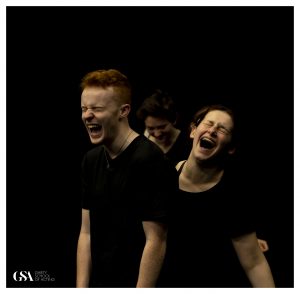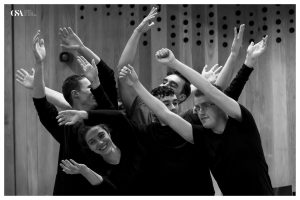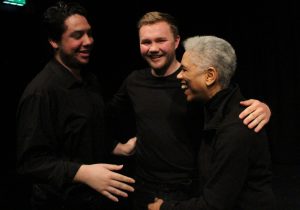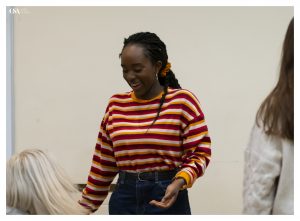Ten questions to keep in mind if you are contemplating the use of humour in your studio teaching
Wednesday, February 10th, 2021 at 11:07 am | News & Events
‘Ten questions to keep in mind if you are contemplating the use of humour in your studio teaching’
by Eric Weitz
Note: This blog is based on an essay I’m ripping off from myself about using humour to teach in the performing arts, in a book coming out next month.* As such, if you are a drama teacher who wants to be funnier in your classes, well, I’ll get to you in a few minutes. If you are a student, by all means spare yourself the trouble of reading any further, because I don’t want you finding out any of the secrets I am trying discreetly to pass along through widespread publication and susbsequent blogging, even though you might find the first half of the essay mildly amusing. (If you’ve taken class with me, I definitely don’t want you to find out that some of the exercises you did in my class retain no higher purpose than getting you to laugh together.)
The editor of the book asked that I include an introductory quote at the beginning, so I made one up:
‘Prized goddess, soul of laughter, won’t be woo’d!’
A Fool’s Errand, Act III, Sc. 4
Willamina Shakespeare
Brace yourself
There are not ten, there is only one: Are you sure you want to do this?
Let me rephrase that: Don’t do it. Do not try to be funny in your classroom or studio. It is seductive, I know, the idea of a group of eager/sullen/bright/distracted students convulsed with laughter at your deftly delivered/wryly observed/daringly subversive/virtuosically performed joke, pratfall or witticism—it is hard to resist. Let me just say this essay is dedicated to those brave teachers who have died humiliating spiritual deaths on the hardwood floors of the conservatory studio.
Granted, some of us can’t help it, so I can understand if you are still reading. No doubt we became addicted to craving the laughter of others early on by being inadvertently amusing beyond the usual excesses of new parents—or were left by seasoned ones in front of the television (or, more recently, video or tablet) to be inscribed with the patterns of cookie-cutter comedy by overexposure to children’s entertainment. And so it is part of my personal gift, which is to say curse, that I cannot help making jokes, especially when I’m sort of trying to get people to like me.
In other words, I am a lost cause. There may still be time for you.
Actually, never mind my over-heated warnings; allow me to share some cautionary items that hopefully will scare you serious:
- Thoroughly unverified data analysis shows that, should you try to be funny in your drama class, you are 3.7 times more likely to cause laughter by accident, and 19.8 times more likely to cause no sound whatsoever, save the pitiable whimper of your self-respect attempting to leave the room before your body knows it is missing. (On the other hand, having foolishly attempted a joke, if you have been able to remain standing amongst the psychological wreckage of its aftermath, you may have opened a door upon redemption. Humbly acknowledge the failure of your effort as evidence that you are, alas, refreshingly human—or else point suddenly to a robbery taking place outside the window and charge heroically out the door.)
- In a study that attempted to simulate the conditions of an acting class under laboratory conditions, a group of mice were given a clown workshop. The results were inconclusive, given the experiment was abandoned as the participants became critically ill after ingesting their teeny red noses. Subsequently, the experiment was scaled down for a sample group of hyenas, who, of course, are known for their low thresholds of sobriety. Nothing much was learned from that one, either, as the workshop leader gave up within five minutes (so be careful what you wish for).
- YouTube is filled with videos of acting teachers being serious, and they are infinitely funnier than you will ever be on purpose.
In case you’re still reading
OK, now. If you are still with us, you have for some reasons not been dissuaded, or else you are procrastinating some other task and so I’m glad to have been of service. Anyway: Forget everything I’ve said. Don’t be silly—there should absolutely be laughter in the studio every bit as much as there should be discipline and slyly eaten chocolate bars.
The occasional outbreak of laughter should at least puncture the brute-force focus on ‘getting it right’ often observed in studio classes. It also stands to supply periodic releases from a student’s concentrated energy upon whatever the hell it is their friend is trying to tell them at the back of the group. The occasional collective laugh might serve to perform a group release of sphinctre muscles clenched in exceedingly earnest dedication to art—plus the ones checking their phones might wonder what they’ve missed.
More to the point, however, is the transactional tool of humour itself and the diabolical fact that laughter, usually its desired outcome, remains a human response to so many other stimuli. Beware, at least, the false positive of deferential laughter from students a) who are angling for a good grade, b) who already like you, or c) who already pity you. (By the way, if you number among the select few who enjoy guru status amongst your students, feel free to ignore this whole article, as they will laugh at anything you want them to—actually, you can ignore the whole book. Have fun.)
Anyway: The whole issue hinges on an assertion by Robert R. Provine, an actual neuroscientist, who says that ‘laughter has more to do with relationships than with jokes’ (Provine, 3). So trying to offer advice is kind of like giving you the keys to my car, when it’s yours you want to drive. Although I suppose you could say I am lending you my car, so you do need the keys. But without knowing what kind of driving you require it for, what the demands would be for roads, topography, and colour preference, how can we know my car will do you any good? And to be perfectly honest I don’t actually own a car. OK, never mind.
Moving on to a thought from another actual scholar: Norman Holland, a twentieth-century psychoanalytic critic, wrote that, ‘In laughing, we suddenly and playfully recreate our identities’ (Holland, 198). And in the metaphor we’ve just agreed to abandon, that would be your car.
What I’m saying is that humour is personal, both in how you joke and what you laugh at, further complicated by social context, its socially established power vectors, and the actual mix of, in this case, students in the room. OK, sorry, I got serious there—hope it didn’t unsettle you. It doesn’t mean that laughter in the studio should be avoided.
Down to funny business
I should therefore like to signal a conscious swerve into a serious lane, in case I can be of actual help: Make THEM do it! As I have just admitted, perhaps too belatedly, there should definitely be laughter in your studio. You might attempt to cultivate the ability to fart on command during strategically laid silences (laughter as cheap as it comes, but effective nonetheless). You can, however, facilitate laughter without having to skirt the precipice or, indeed, sacrifice any self-respect you still have: Assist your students in causing each other to laugh, which is quite good for morale, by which I mean your morale, and should have some benefits for them, too.
Most kidding aside, you can introduce laughter into your studio virtually risk-free by drawing upon games and exercises that fall into four general categories: Children’s games, Silly games, Confusion games, and Forced Incongruity exercises. I would be confident that experienced teachers already know games that fall into these categories. In any case, there are books and websites to be scoured, and I know they harbour all of these games and more.
CHILDREN’S GAMES
Children’s games would include, well, children’s games, that is, games that most of us recall from once upon a time. Obvious ones would include versions of Tag, Hide and Seek, and Red Light Green Light. You can even ask students to think of a game they used to play and teach it to the group. Whether through an unexpected connection to times past or the playground simplicity of their rules, these kinds of games can re-frame childlike spirit as a power source for creativity. For the most part, students seem to throw themselves into these games with a fullness of intention sometimes missing from what are considered more proper studio work. I have found the laughter of the playground to be both recalled and updated as a player is ‘caught’ or ‘wins’, and you often find teachable moments regarding ingenuity and discovery in these reclaimed pastimes.
SILLY GAMES
There are a number of games based on sheer silliness, even though I do not actually know what that number is. One of them I learned as ‘Scream Circle’, and is often one of the first games I play with a new group: With students in a circle, the starting position involves all participants looking at the ground. At a command from the instructor, everyone looks either at one of the people on either side of them or at someone across the circle. If the person you find yourself looking at is looking back at you, you both scream. Hopefully something piercing and blood-curdling. Consciously breaking social constraints on decorum and getting everyone to make a spectacle of themselves right away—aurally and facially—always brings laughter, sometimes relief or anxiety oriented, but laughter nonetheless.
‘Bomb and Shield’ is extremely simple and leads to frantic activity, from which the next step is always laughter, either at the point of peak panic or the instant the game is over. It is good to have a somewhat spacious but contained place to play. You can begin the game by having everyone choose another participant as their ‘bomb’, a choice that they keep to themselves. Players begin to move around the space randomly, but must try to keep as much distance as possible between them and their bomb, lest, of course, the bomb should explode suddenly. Play for a few minutes to get the idea. Then each player chooses a separate participant to be their ‘shield’, and their identity also is not shared with anyone else; the shield if kept between player and bomb protects the player if the bomb explodes. Players then have to try to keep their shield between them and their bomb, with the leader eventually counting down momentously until the bomb will ‘go off’. Trust me, it will become a spectacular, chaotic free-for-all.
A game that is resolutely anti-serious and trades, as in the above games, on uses of the body that both puncture socially appropriate modes of comportment, while also hearing and producing sounds not met in contexts this side of, well, acting classes, is likely to harvest laughter providing release of new-class anxieties and assisting in communal bonding.
CONFUSION GAMES
Games that emphasise the desirability of letting go by placing laughably challenging demands on all the participants are good for dissolving a pressure to perform in beginning students or at the start of a school year. At the beginning of Improvisation in Drama (Second Edition), by Anthony Frost and Ralph Yarrow, the authors offer a parable of juggling instructors who start off their new charges by telling them simply to ‘let the balls drop’ (Frost and Yarrow, 4), avoiding the frenzied flailing that accompanies most students’ initial attempts.
The games may not themselves be built on an intent to confuse, but to focus. If, however, you overload noise, action and demand to the point that it will be all but impossible to focus, things will fall apart. Laughter usually ensues as society’s bodily inscribed injunctions for success clatter to pieces on the floor of the studio playground and the ‘balls are allowed to drop’. Laughter in these kinds of games is liberating and, again, unifying for the group spirit.
A game called Red Ball is one such candidate, especially once the group has been given too many imaginary balls (adding Yellow Ball, Green Ball, Magenta Ball, Chartreuse Ball, etc.) to keep track of with any ease (and you can use different kinds of balls, such as superballs, beach balls, bowling balls, crystal balls, etc.). Another is one I learned as Zip Zap Bloing (and which seems to have a number of other substitutions for Bloing). It is not confusing in its basic form but becomes so when, say, three or four impulses are in play at any given time. Zip Zap Bloing played in extremely slow motion isn’t confusing, but it does tend to generate laughter.
FORCED INCONGRUITY EXERCISES
Games built to produce incongruity are useful exercises in unselfconscious spontaneity and generally come with an added reward because the subversion of logic is, of course, the triggering mechanism for laughter. The crux of one game I have found to cause laughter can be found in The Improv Handbook in an untitled description for two players (Salinsky and Frances-White, 82), and I think of it as ‘Words in Ears’. It can be played in pairs, in which one person begins impromptu speaking while the other periodically (say every ten to 15 seconds) tosses a random word at them, which they have to incorporate into their ‘monologue’ as quickly as possible. With more than two people (three or four), it can be set up as a dialogue: Two speakers simply begin talking. With four in a group, each speaker can have their own ‘word whisperer’, standing to their side. If there are three in the group, then the third person alternates whispering a word in the ears of both speakers. Whispered words should come with some regularity. Again, the speakers are required to incorporate each new word into the conversation as soon as possible. No matter how many students in the class, you can usually find a combination of threes and fours (even twos), to suit the total number playing. The fact that it is low focus—nobody outside one’s group is watching, except, possibly the teacher—smooths relaxation and a sense of shared experience. This game always produces laughter, at least in part because it is built around forced incongruity in terms of the random ‘words in ears’. I believe there is also a sort of celebratory element to the laughter, in that no matter how impossible the immediate prospect of incorporating any given word, it always happens somehow, i.e., I have never seen anyone simply give up. This, I believe, enhances the laughter.
There are other such games, in some cases more physical, like ‘People As Objects’ (Nevraumont and Hanson, 178-9), that are built upon a concept that prevents planned responses while encouraging incongruity through word and body. My experience is that there will be laughter in all these games, so I use them as both icebreakers and rewards. There should be laughter in the studio—it is a proper sound of collective, creative endeavour. Only let the students work for it, which is to say, play for it. And for God’s sake, be careful out there.
Conclusion
Oh, sorry, too late.
————
Cited Sources
Frost, Anthony and Ralph Yarrow. Improvisation in Drama (Second Edition). Houndmills: Palgrave Macmillan, 2007.
Holland, Norman. Laughing: A Psychology of Humor. Ithaca: Cornell University, 1982.
Nevraumont, Edward J. and Nicholas P. Hanson, additional material from Kurt Smeaton. The Ultimate Improv Book: A Complete Guide to Comedy Improvisation. Colorado Springs: Meriwether, 2001
Provine, Robert R. Laughter: A Scientific Investigation. Harmondsworth: Penguin, 2001.
Salinsky, Tom and Deborah Frances-White. The Improv Handbook: The Ultimate Guide to Improvising in Comedy, Theatre, and Beyond. New York: Continuum, 2008.
* Teach Performing Arts With a Sense of Humor: Why (and How to) Be a Funnier and More Effective Performing Arts Teacher and Laugh All the Way to Your Classroom, ed. by Kishor Vaidya. Curious Academic Publishing, 2021.




